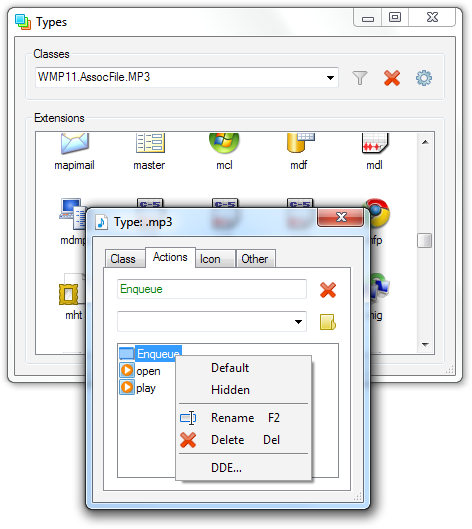Windows has a utility called Default Programs that allows you to configure or change the default applications associated with specific file extensions. This feature was added to Windows XP through Service Pack 1, and comes default in later versions of Windows. While the Default Programs utility was revamped and made more useful in Windows Vista and 7, a particular feature found in Windows XP edition of the utility was taken away. That was the ability to change the default action when a file with a specific extension was double-clicked in Windows Explorer.
Types is a simple freeware utility that makes the task of changing program associations, icons and context menus a lot easier. More so because it brings back the ability to change the default action that was removed in Windows 7 and Vista.
Types integrates with Windows Explorer, adding a new ‘Edit file type’ action to the context menu. So you can simply right click on a particular file type and easily change the default program associated with it. Alternatively, you can access Types from The Control Panel.

Once Types is launched, you can change default program by choosing the appropriate item from the Linked Class menu. From the actions menu you can change the default behavior of the program when executed. These action appear on the context menu of files of that particular file type. For instance, the default behavior of MP3 files is to play when double clicked in explorer. You can push down the ‘Play’ action and instead make MP3 files add to a queue in Media Player.
What I liked most was the ability to force Windows explorer to show a particular file extension even though explorer is configured to hide them.

The file extensions is displayed in the File types column while in details mode, which is different from the way explorer displays file types when the ‘hide file extension’ option is unchecked in Folder settings. When explorer is asked to display file types, it shows the full file name along with the extension in the file name column. This often causes problems when renaming files, as you have to be extra careful not to change the extension. This problem is absent in Types.
The drawback is that you have to manually edit each file extension setting in Types. Technically, this is impossible to accomplish since there are hundreds of extensions, but for all practically purposes, we only deal with a dozen or a couple of dozen different file extensions at most. So this is perfectly doable.
Types supports all Windows versions starting with XP.

Comments
Post a Comment